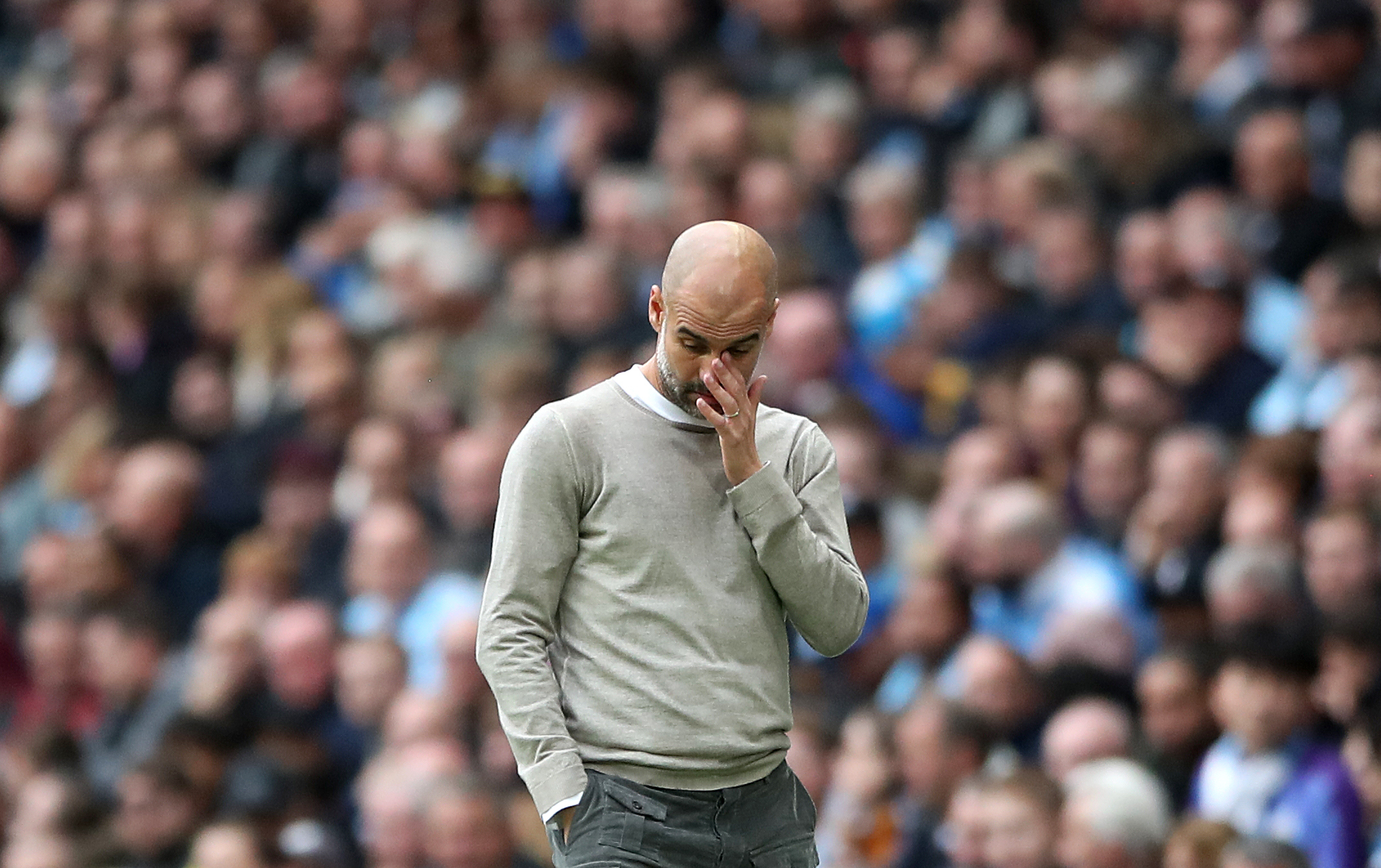Are there real problems here? For the previous two years, Manchester City have been as close to perfect as we have ever seen in the Premier League. 198 points, 201 goals scored, 50 conceded across 76 games is as good as it’s ever been in England’s top flight. This is the pinnacle. So it’s perhaps inevitable that even a minor dip in performance gets scrutinised to death. But, nevertheless, scrutinise we shall, and there are real concerns about this City side that did not exist in previous years. On the attacking end, it looks fine. More than fine, in fact. The 2.87 expected goals per game is better than ever. While in previous years things were more balanced, it seems as though Pep Guardiola has tweaked his system to really allow Kevin De Bruyne to do his thing. With David Silva at age 33 becoming more of a rotation option than one of the first names on the teamsheet, City have experimented with pushing De Bruyne into a more advanced role as a number ten in which he, at times, seems to be pushed up right alongside the striker. Against Shakhtar Donetsk, for example, the passmap shows him just as advanced as Gabriel Jesus, with City really looking like a 4-2-4 in possession. 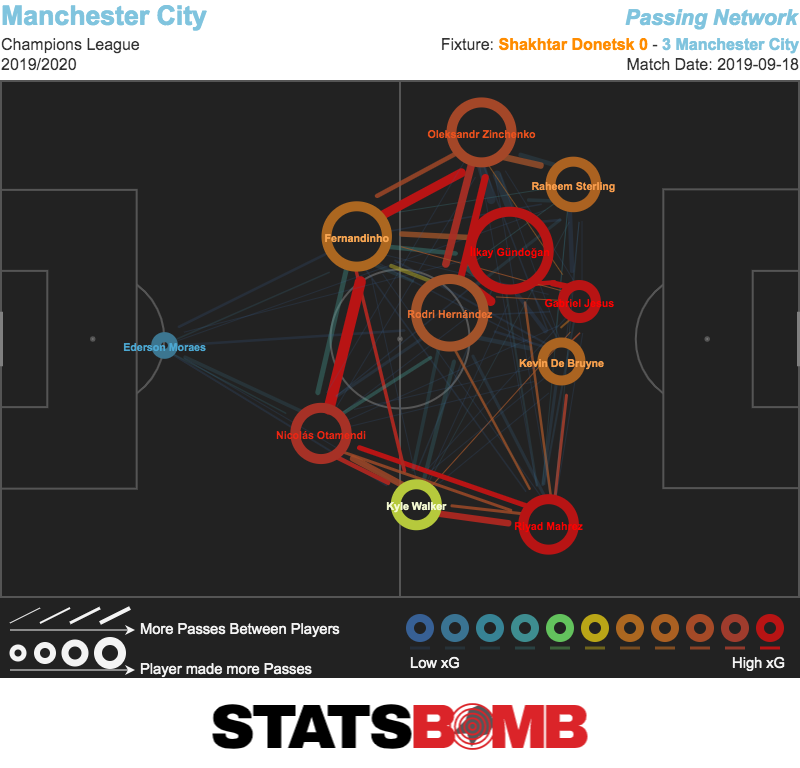 The one significant time Guardiola employed this tactic in his career was a stretch in in early 2010, when he was attempting to move Lionel Messi into a more central role but still felt the need for a “proper” striker, with Messi fielded as a number ten who could take up centre forward positions. That De Bruyne has been given a role once created for Messi is obviously a great credit to the Belgian, and he’s really thriving in it. He might be touching the ball in very advanced areas, but he’s still unquestionably a playmaker, and his 0.7 open play xG assisted per 90 is defying all known logic. On these grounds, it’s forgivable that City’s attack stuttered against Wolves when everything has been funnelled towards one man who wasn’t available.
The one significant time Guardiola employed this tactic in his career was a stretch in in early 2010, when he was attempting to move Lionel Messi into a more central role but still felt the need for a “proper” striker, with Messi fielded as a number ten who could take up centre forward positions. That De Bruyne has been given a role once created for Messi is obviously a great credit to the Belgian, and he’s really thriving in it. He might be touching the ball in very advanced areas, but he’s still unquestionably a playmaker, and his 0.7 open play xG assisted per 90 is defying all known logic. On these grounds, it’s forgivable that City’s attack stuttered against Wolves when everything has been funnelled towards one man who wasn’t available. 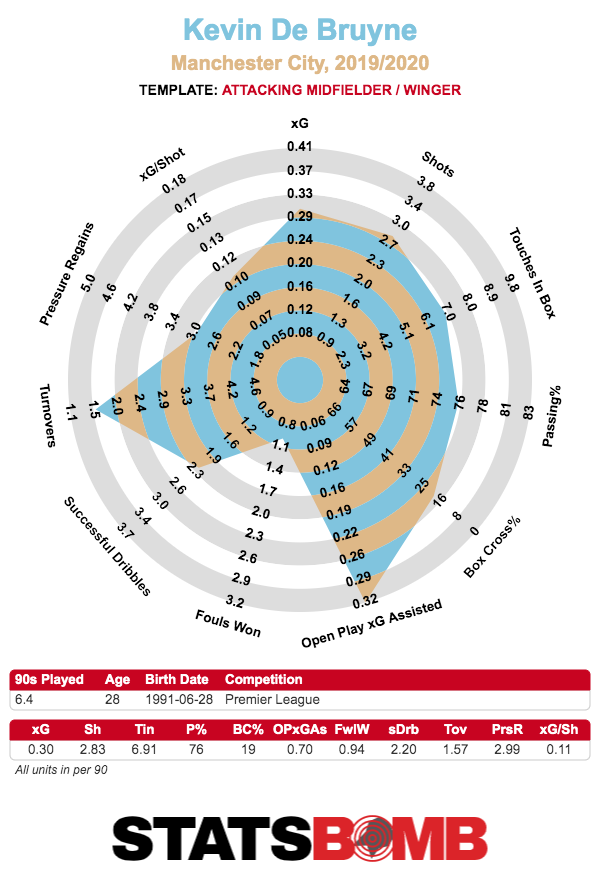 It doesn’t take a genius to figure out that the real concerns, however, are on the defensive side. Nine goals conceded in eight matches is obviously a sharp rise from the 0.6 goals against per game of last season, but is it just a weird finishing run? When looking at the raw shot counts, it seems that way. City are allowing seven shots against per game, just a fraction worse than last season’s 6.29 and still, as usual, the best in the league.
It doesn’t take a genius to figure out that the real concerns, however, are on the defensive side. Nine goals conceded in eight matches is obviously a sharp rise from the 0.6 goals against per game of last season, but is it just a weird finishing run? When looking at the raw shot counts, it seems that way. City are allowing seven shots against per game, just a fraction worse than last season’s 6.29 and still, as usual, the best in the league. 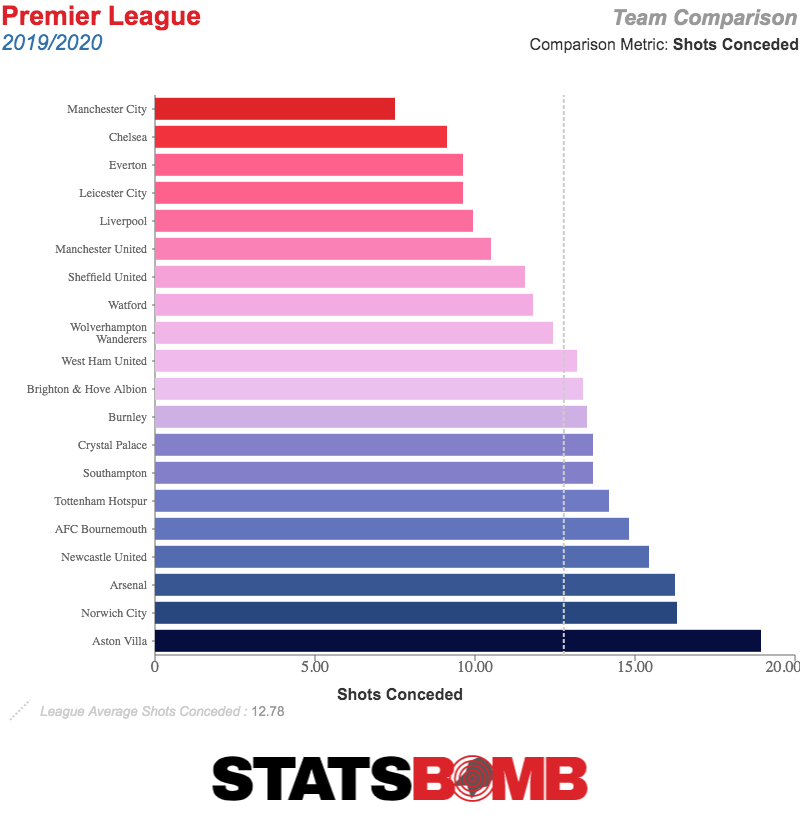 Of course shot volume doesn’t tell the whole story. The reason we have expected goals models is to find the outstanding cases where shot quality is playing a decisive role. And here’s where things get worrying. Last season, City had an xG per shot conceded of 0.09, around league average. This isn’t how a side that presses the ball as high up the pitch as City would typically operate. The point of a high press is that you limit the number of shots your opponent is able to take. The risk, though, is that once the opposition breaks your press, you’re badly exposed, and they can carve out an excellent scoring opportunity. That this team could press opponents so hard to concede the fewest shots in the league while also making sure those shots were only of middling quality seemed like genuine magic. And this is where we find the leak. City’s xG per shot conceded this season is 0.17, nearly double that of last year and the worst in the Premier League.
Of course shot volume doesn’t tell the whole story. The reason we have expected goals models is to find the outstanding cases where shot quality is playing a decisive role. And here’s where things get worrying. Last season, City had an xG per shot conceded of 0.09, around league average. This isn’t how a side that presses the ball as high up the pitch as City would typically operate. The point of a high press is that you limit the number of shots your opponent is able to take. The risk, though, is that once the opposition breaks your press, you’re badly exposed, and they can carve out an excellent scoring opportunity. That this team could press opponents so hard to concede the fewest shots in the league while also making sure those shots were only of middling quality seemed like genuine magic. And this is where we find the leak. City’s xG per shot conceded this season is 0.17, nearly double that of last year and the worst in the Premier League. 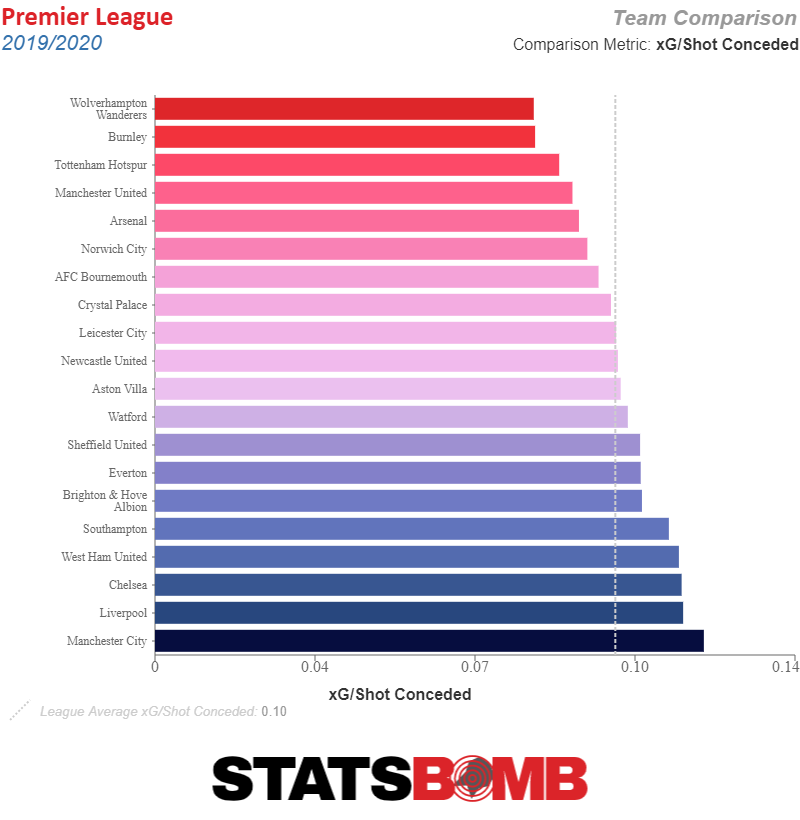 City concede the second fewest deep completions in the league and the second fewest opponent passes inside their own box. Teams still find it awfully difficult to get the ball up the pitch against Guardiola’s side and generate shots. But, once they do work it into dangerous areas, it seems to be easier than ever to turn those situations into good chances. They are about level in terms of goals conceded vs expected, having let in nine against an xG of 9.74. But this looks worse when you factor in post-shot information. City have needed Ederson to bail them out at times and he is delivering, saving nearly two goals more than expected on the post-shot model. Most likely, this just means that opposing players have happened to strike the ball well and Ederson stepped up to the plate. But it might be conceivable that the chances City are conceding could be of even higher quality than the pre-shot model thinks, and the post-shot data is picking up on something that’s happening. It’s not an accident that City have the defensive issues one would expect of a high pressing side with some problems. When looking at the team’s defensive distance, the average location up the pitch where they attempt a defensive action, it shows that City are pressing higher than ever. In fact, City have been gradually defending further and further up the pitch for the past twelve months.
City concede the second fewest deep completions in the league and the second fewest opponent passes inside their own box. Teams still find it awfully difficult to get the ball up the pitch against Guardiola’s side and generate shots. But, once they do work it into dangerous areas, it seems to be easier than ever to turn those situations into good chances. They are about level in terms of goals conceded vs expected, having let in nine against an xG of 9.74. But this looks worse when you factor in post-shot information. City have needed Ederson to bail them out at times and he is delivering, saving nearly two goals more than expected on the post-shot model. Most likely, this just means that opposing players have happened to strike the ball well and Ederson stepped up to the plate. But it might be conceivable that the chances City are conceding could be of even higher quality than the pre-shot model thinks, and the post-shot data is picking up on something that’s happening. It’s not an accident that City have the defensive issues one would expect of a high pressing side with some problems. When looking at the team’s defensive distance, the average location up the pitch where they attempt a defensive action, it shows that City are pressing higher than ever. In fact, City have been gradually defending further and further up the pitch for the past twelve months. 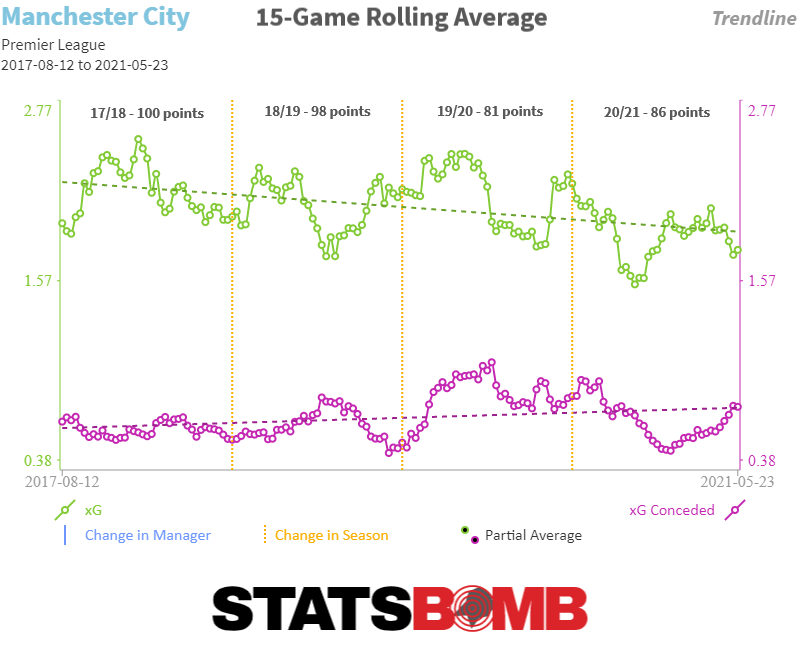 This wasn’t causing the side defensive issues until very recently. Perhaps they recently took it a little too far and the dam broke, or perhaps the issue lies somewhere else.
This wasn’t causing the side defensive issues until very recently. Perhaps they recently took it a little too far and the dam broke, or perhaps the issue lies somewhere else. 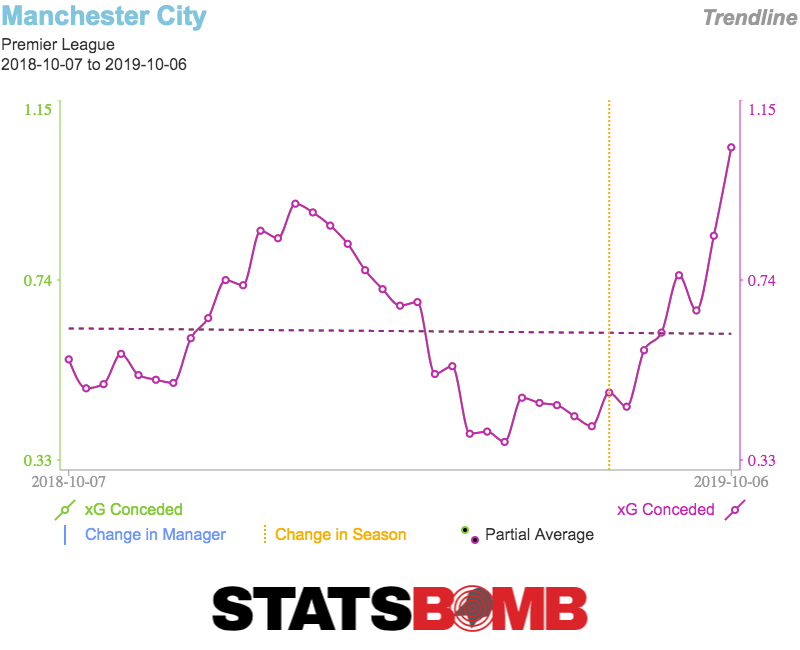 So the question comes to personnel. The one significant arrival to the team (sorry, João Cancelo, but you’re going to have to play more football before you count here) was Rodri as the “Fernandinho replacement”. Purely in terms of defensive output, there doesn’t seem to be an issue here.
So the question comes to personnel. The one significant arrival to the team (sorry, João Cancelo, but you’re going to have to play more football before you count here) was Rodri as the “Fernandinho replacement”. Purely in terms of defensive output, there doesn’t seem to be an issue here.  The dirty little not-so-secret about Fernandinho’s role for City has always been his tactical fouling, and purely in the numbers, it seems fine here. Rodri is making 2.82 fouls per 90, more than Fernandinho’s rate of 2.52 last season. But there are some differences we can observe in location. These are all of the Brazilian’s fouls last year. The obvious thing that stands out is that the vast majority were in the middle third of the pitch, with a good chunk in the opposition’s final third, and relatively few in his own defensive third.
The dirty little not-so-secret about Fernandinho’s role for City has always been his tactical fouling, and purely in the numbers, it seems fine here. Rodri is making 2.82 fouls per 90, more than Fernandinho’s rate of 2.52 last season. But there are some differences we can observe in location. These are all of the Brazilian’s fouls last year. The obvious thing that stands out is that the vast majority were in the middle third of the pitch, with a good chunk in the opposition’s final third, and relatively few in his own defensive third. 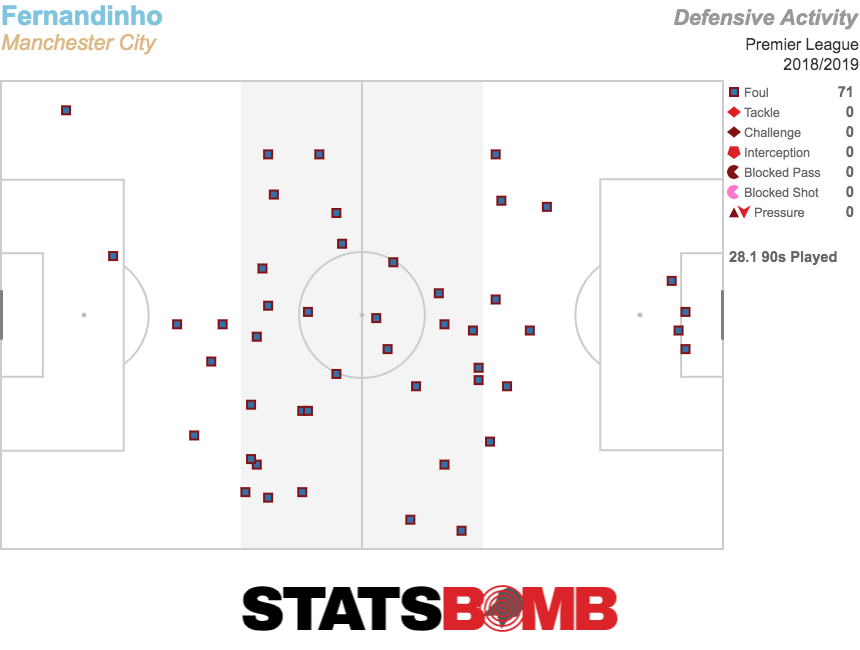 Now here are Rodri’s this season. Despite playing only a fraction of the minutes, he’s nearly made as many fouls in his own defensive third as Fernandinho did in all of last year. Are these “tactical” fouls, or simply fouls that you don’t want to give away? It’s not obvious.
Now here are Rodri’s this season. Despite playing only a fraction of the minutes, he’s nearly made as many fouls in his own defensive third as Fernandinho did in all of last year. Are these “tactical” fouls, or simply fouls that you don’t want to give away? It’s not obvious.  One thing Rodri perhaps lacks in the role is mobility. This might be part of Guardiola’s thinking in the new shape, putting Ilkay Gündoğan alongside the Spaniard in a double pivot, giving him some assistance and lessening the size of the area in which he needs to offer defensive cover. It’s not clear what exactly Gündoğan is offering in this regard. He isn’t a particularly aggressive ball winner. He’s not a tactical fouler, making less than one foul per 90. And he’s not especially adventurous in his passing. If adding him into a double pivot clearly isn’t making the side more stable, what is the point of him being there?
One thing Rodri perhaps lacks in the role is mobility. This might be part of Guardiola’s thinking in the new shape, putting Ilkay Gündoğan alongside the Spaniard in a double pivot, giving him some assistance and lessening the size of the area in which he needs to offer defensive cover. It’s not clear what exactly Gündoğan is offering in this regard. He isn’t a particularly aggressive ball winner. He’s not a tactical fouler, making less than one foul per 90. And he’s not especially adventurous in his passing. If adding him into a double pivot clearly isn’t making the side more stable, what is the point of him being there?  Obviously the other significant issue is Aymeric Laporte’s injury. It’s worth mentioning that City were not without defensive concern before then. Laporte played the full 90 minutes away at Bournemouth in a game where City conceded 1.63 xG from 10 shots. But it also seems fairly indisputable that the current pairing of Nicolás Otamendi and no-longer-midfielder Fernandinho are not fully capable of doing what is being asked of them. The issue is probably being magnified by what’s in front of them. It often felt like City’s pressing structure was so good, so complete, that you could play anyone at centre back and they’d have so little to do that it wouldn’t matter. The defensive injuries have come at the worst possible time for City in that the centre backs are being asked to do more decisive defending than ever. They’re not delivering on that front. All things considered, City are still a very good football team. Their xG difference per game of +1.86 is still comfortably the best in the Premier League, though it’s down to a hugely dominant attack overpowering the ninth best defence. The manager is, you know, not bad at his job. Liverpool have issues of their own. If the season reset to zero tomorrow, City would still be the clear favourites. An eight point gap is a real thing, though. For City to bridge it, they need to start playing their best football again as soon as possible. If these issues drag into the winter months, then things could become very difficult for the blue side of Manchester.
Obviously the other significant issue is Aymeric Laporte’s injury. It’s worth mentioning that City were not without defensive concern before then. Laporte played the full 90 minutes away at Bournemouth in a game where City conceded 1.63 xG from 10 shots. But it also seems fairly indisputable that the current pairing of Nicolás Otamendi and no-longer-midfielder Fernandinho are not fully capable of doing what is being asked of them. The issue is probably being magnified by what’s in front of them. It often felt like City’s pressing structure was so good, so complete, that you could play anyone at centre back and they’d have so little to do that it wouldn’t matter. The defensive injuries have come at the worst possible time for City in that the centre backs are being asked to do more decisive defending than ever. They’re not delivering on that front. All things considered, City are still a very good football team. Their xG difference per game of +1.86 is still comfortably the best in the Premier League, though it’s down to a hugely dominant attack overpowering the ninth best defence. The manager is, you know, not bad at his job. Liverpool have issues of their own. If the season reset to zero tomorrow, City would still be the clear favourites. An eight point gap is a real thing, though. For City to bridge it, they need to start playing their best football again as soon as possible. If these issues drag into the winter months, then things could become very difficult for the blue side of Manchester.
2019
What’s up with Manchester City?
By admin
|
October 9, 2019
